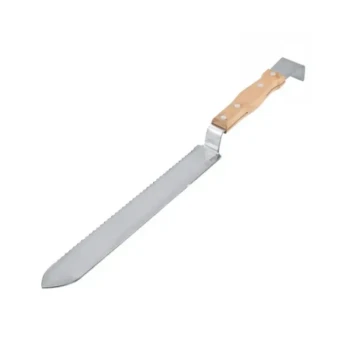A standard deep bee box has a precise depth of 9 9/16 inches (or 243 mm). This measurement is the cornerstone of the Langstroth hive system, the most common type of hive used in modern beekeeping. This specific size is not arbitrary; it is designed to serve as the hive's "brood chamber," the area where the queen lays her eggs and the colony raises its young.
While the simple answer is a measurement, the deeper truth is that hive box depth dictates function. The "deep" box is intentionally sized to support the colony's core need—raising brood—while other, shallower boxes are designed for the beekeeper's convenience in harvesting honey.

The Role of Box Depth in Hive Management
The dimensions of hive equipment are standardized to ensure parts from different manufacturers are interchangeable. This system, known as the Langstroth hive, revolves around different box depths, each with a specific purpose.
The "Deep" as the Brood Chamber
A deep box is almost universally used as the primary living quarters for the bee colony. Its substantial volume provides the queen with ample space to lay thousands of eggs per day without becoming "honeybound," a condition where incoming nectar limits her laying space.
Most beekeepers use either one or two deep boxes to form the main body of the hive, called the brood nest.
Other Common Box Sizes
To understand the deep box, it's helpful to compare it to the other standard sizes. These shallower boxes, often called "supers," are typically placed on top of the brood chamber for honey storage.
- Medium (6 5/8"): Often called an "Illinois" or "Western" super, this is a versatile size. It can be used as a honey super or, by beekeepers who want to avoid lifting heavy deeps, can also be used for brood chambers.
- Shallow (5 3/4"): Used almost exclusively as a honey super. Its lighter weight when full of honey makes it much easier to lift and harvest.
- Comb Super (4 3/4"): This is a more specialized, even shallower box designed for producing cut comb honey, where the entire honeycomb is harvested.
Understanding the Trade-offs
Choosing a hive configuration is about balancing the needs of the bees with the physical capabilities of the beekeeper. Each box size comes with distinct advantages and disadvantages.
Deep Box: Maximum Space vs. Extreme Weight
The primary benefit of a deep box is providing a large, uninterrupted area for the queen's brood nest. However, its significant drawback is weight. A deep box full of brood, pollen, and honey can easily weigh 80-90 pounds (36-41 kg), making inspections a serious physical challenge.
Mediums: Flexibility vs. More Equipment
Using all medium boxes for both brood and honey is a popular alternative. This creates a uniform system where all boxes and frames are interchangeable. The major benefit is that a full medium box is significantly lighter than a deep. The trade-off is that you need more boxes to equal the volume of a deep, leading to more frames to inspect.
Shallows: Easy Lifting vs. Lower Volume
Shallow supers are the easiest to handle, as a full box of honey is the most manageable weight. Their disadvantage is a lower storage volume, meaning you may need to add more supers more frequently during a strong nectar flow to prevent the hive from swarming.
Making the Right Choice for Your Goal
Your beekeeping goals and physical ability should dictate your equipment choices.
- If your primary focus is a traditional setup: Start with one or two deep boxes for the brood chamber and use medium or shallow boxes for honey supers.
- If your primary focus is minimizing heavy lifting: Run your entire hive using all medium boxes for both the brood nest and honey supers.
- If your primary focus is simple honey harvesting: Use deeps for brood and add shallow supers for honey, as they are the easiest to lift when full.
Ultimately, understanding these standard dimensions empowers you to build a hive that works for both your bees and you.
Summary Table:
| Box Type | Depth (inches) | Depth (mm) | Primary Function |
|---|---|---|---|
| Deep | 9 9/16" | 243 mm | Brood Chamber |
| Medium | 6 5/8" | 168 mm | Brood or Honey Super |
| Shallow | 5 3/4" | 146 mm | Honey Super |
| Comb Super | 4 3/4" | 121 mm | Cut Comb Honey |
Ready to build or expand your apiary with the right equipment?
HONESTBEE supplies high-quality, standard-dimension beekeeping supplies and equipment to commercial apiaries and distributors through our wholesale-focused operations. Whether you need durable deep boxes for brood chambers or lightweight supers for an efficient honey harvest, we provide the reliable gear your operation depends on.
Contact HONESTBEE today for wholesale pricing and to discuss your specific equipment needs.
Visual Guide

Related Products
- Portable Bee Mating Hive Boxes Mini Mating Nucs 8 Frames for Queen Rearing
- Langstroth Honey Bee Box Hive Boxes for Different Depths
- Plastic Transporting Bee Packages and Nuc Boxes for Beekeeping
- HONESTBEE Professional Entrance Bee Feeder Hive Nutrition Solution
- Long Langstroth Style Horizontal Top Bar Hive for Wholesale
People Also Ask
- What is a baby nuc or mating nuc used for? A Guide to Efficient Queen Rearing
- What are the two types of nucs? Choose the Right Nuc for Your Beekeeping Goals
- What happens if a nuc is left queenless? Prevent Swarming and Colony Collapse
- How are nuc boxes used in queen rearing? The Essential Tool for Reliable Queen Mating
- What are the benefits of using small nucs for raising and mating queens? Maximize Queen Production Efficiency



















